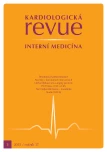The implications of the new 2013 European guidelines for cardiac stimulation and heart-resynchronisation therapy in the area of arrhythmia diagnostics through long-term ECG monitoring. Current technical parameters and types of long-term ECG monitoring
Authors:
L. Rambousková; M. Novák
Authors‘ workplace:
I. interní kardioangiologická klinika LF MU a FN u sv. Anny v Brně
Published in:
Kardiol Rev Int Med 2015, 17(3): 245-248
Category:
Cardiology Review
Overview
Long-term ECG monitoring has been used in clinical practice for more than 80 years. Over this period it has undergone steady development concerning indication criteria, types of monitoring devices and their software. The new 2013 European guidelines for cardiac stimulation and heart-resynchronisation therapy emphasise the importance of typical clinical symptoms of specific arrhythmias and their frequency in the selection process for the appropriate monitoring device. In this article we will focus on the technical aspects of long-term monitoring: noninvasive (recorders) and invasive (implantable recorders and recorders integrated within PM and ICDs) devices; continual, loop and episodic recorders. The yield of monitoring increases with the length of monitoring and is higher in automatically-activated devices. The devices are used to monitor mainly arrhythmias, ischaemia, RR and QT interval variability, etc. The article highlights the importance of long-term monitoring for the evaluation of the effect of various therapies (e.g. pharmacological therapy, surgical ablation, percentage of HRT, evaluation of patients after stroke) and adverse effects of drugs. Finally, individual types of ECG monitoring are described.
Keywords:
long-term ECG monitoring – principles and indicators for ECG monitoring – ECG Holter – loop recorder – rhythm-card – implantable ECG recording devices
Sources
1. 2013 ESC Guidelines on cardiac pacing and cardiac resynchronization therapy. Eur Heart J 2013; 34 : 2281 – 2329. doi: 10.1093/ eurheartj/ eht150.
2. Crawford MH, Bernstein SJ, Deedwania PC et al. ACC/ AHA Guidelines for Ambulatory Electrocardiography. JACC 1999; 34 : 912 – 948.
3. Thomsen PEB, Jons Ch, Raatikainem MJP et at. Long‑Term Recording of Cardiac Arrhythmias With an Implantable Cardiac Monitor in Patients With Reduced Ejection Fraction After Acute Myocardial Infarction: The Cardias Arrhythmias and Risk Stratification After Acute Myocardial Infarction (Carisma) Study. Circulation 2010; 122 : 1258 – 1264. doi: 10.1161/ CIRCULATIONAHA.109.902148.
4. Joshi S, Choi AD, Kamath GS et al. Prevalence, predictors, and prognosis of atrial fibrillation early after pulmonary vein isolation: findings from 3 months of coutinuous automatic ECG loop recordings. J Cardiovasc Electrophysiol 2009; 20 : 1089 – 1094. doi: 10.1111/ j.1540 - 8167.2009.01506.x.
5. Lazarus A, Remote, wireless, ambulatory monitoring of implantable pacemakers, cardioverters defibrillators, and cardiac resynchronization therapy systems: analysis of a worldwide database. Pacing Clin Electrophysiol 2007; 30 (Suppl 1): S2 – S12.
6. Ricci RP, Morichelli L, Santini M. Remote control of implanted device through Home Monitoring technology improves detection and clinical management of atrial fibrillation. Europace 2009; 11 : 54 – 61. doi: 10.1093/ europace/ eun303.
7. Jabaudon D, Sztajzel J, Sievert K et al. Usefulness of ambulatory 7 - day ECG monitoring for the detection of atrial fibrillation and flutter after acute stroke and transient ischemic attack. Stroke 2004; 35 : 1647 – 1651.
8. Roten L, Schilling M, Häberlin A et al. Is 7 – day event triggered ECG monitoring equivalent to 7 - day Holter ECG recording for atrial fibrillation screening? Heart 2012; 98 : 645 – 649. doi: 10.1136/ heartjnl ‑ 2011 – 301455.
9. Roche F, Gaspoz JM, Da Costa A et al. Frequent and prolonged asymptomatic episodes of paroxysmal atrial fibrillation revaled by automatic long‑term event recorders in patiens with a negative 24 - hour Holter. Pacing Clin Electrophysiol 2002; 25 : 1587 – 1593.
10. Chovančík J, Bulková V, Fiala M. Monitorování EKG po ablaci fibrilace síní. Interv Akut Kardiol 2012; 11 : 187 – 191.
11. Wichterle D, Bulková V. Monitorace léčby fibrilace síní. Postgrad Med 2010; 12 : 529 – 533.
12. Táborský M, Neužil P, Kupec J et al. Současné možnosti dálkového sledování pacientů s implantabilním kardioverterem ‑ defibrilátorem. Postgrad Med 2009; 11 : 1018 – 1022.
Labels
Paediatric cardiology Internal medicine Cardiac surgery CardiologyArticle was published in
Cardiology Review

2015 Issue 3
Most read in this issue
- Cardiac arrest and post‑cardiac arrest care
- Therapeutic approaches in exertional angina pectoris
- Leadless cardiac stimulation – future or fiction?
- A new device in intervention therapy of heart failure with preserved ejection fraction of left ventricle
